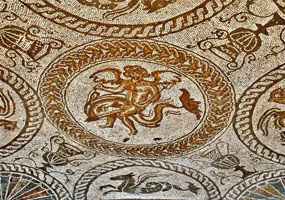Fishbourne Roman Palace, West Sussex

Fishbourne Roman Palace, located near Chichester in West Sussex, approximately 16 miles from Portsmouth, is the largest known Roman residential building discovered in Britain. It dates back to the late 1st century AD and is believed to have been constructed around 75 AD, making it contemporary with early Roman London. The palace is thought to have been built for a high-ranking Roman official, possibly Tiberius Claudius Cogidubnus, a local British ruler who was an ally of the Romans.
The palace was originally a grand and luxurious residence, featuring extensive gardens, elaborate mosaics, and sophisticated architectural elements. It was constructed in a layout similar to a classical Roman villa, with a central courtyard surrounded by living quarters and reception rooms. Over time, the palace expanded to cover more than 5 acres, making it one of the largest Roman buildings north of the Alps.
One of the most notable features of Fishbourne Roman Palace is its collection of well preserved mosaics, which include intricate geometric designs and depictions of mythological figures. These mosaics provide valuable insight into Roman art and craftsmanship in Britain. The palace also had an advanced underfloor heating system, known as a hypocaust, and sophisticated plumbing, showcasing the high standard of Roman engineering.
The site was discovered in 1960 during construction work and has since been extensively excavated and studied. Today, Fishbourne Roman Palace is managed by the Sussex Archaeological Society and serves as a museum and archaeological site. Visitors can explore the remains of the palace, view the mosaics, and learn about Roman life in Britain through interactive exhibits and displays. The site also features reconstructed Roman gardens, which are planted with species known to have been cultivated during the Roman period, offering a glimpse into the horticultural practices of the time.

Portsmouth born archeologist Barry Cunliffe, Professor of Archaeology at the University of Southampton at the time, worked on the systematic excavation of Fishbourne Roman Palace between 1961 - 1968, discovering many of the mosaic floors on display today.
Key features at Fishbourne Roman Palace
At Fishbourne Roman Palace, visitors can explore a range of fascinating exhibits and features that highlight the opulence and sophistication of Roman life in Britain. Key attractions include:
Mosaics: The palace is renowned for its impressive collection of Roman mosaics, many of which are beautifully preserved. These intricate floor designs, featuring geometric patterns and depictions of mythological figures such as Cupid and a dolphin, are some of the finest examples of Roman art in Britain.
Archaeological Site: Visitors can walk through the remains of the palace and see the original layout of the building, including the central courtyard, living quarters, and reception rooms. Information boards and interactive displays provide insights into how the palace would have looked and functioned during its peak.
Roman Gardens: The reconstructed gardens are based on archaeological evidence and provide a glimpse into Roman horticultural practices. The gardens feature symmetrical flowerbeds, box hedges, and plants known to have been cultivated by the Romans, offering a serene and authentic historical setting.
Museum Exhibits: The on-site museum houses a variety of artifacts uncovered during excavations, including pottery, tools, jewelry, and household items that provide a deeper understanding of daily life in the palace. There are also displays explaining the history of the site and its excavation.
Interactive Displays: The museum offers interactive exhibits and activities, including a model of the palace, digital reconstructions, and opportunities to learn about Roman engineering and craftsmanship.
Learning and Family Activities: Fishbourne Roman Palace often hosts educational programs, workshops, and family-friendly activities such as mosaic-making sessions and guided tours, making it an engaging experience for visitors of all ages.
Overall, Fishbourne Roman Palace offers a comprehensive and immersive exploration of Roman history and culture, allowing visitors to step back in time and experience the grandeur of Roman Britain.
Fishbourne Roman Palace details:
- Address: Salthill Road, Fishbourne, West Sussex, PO19 3QR
- Telephone: 01243 785859
- Rail: 5 minute walk from Fishbourne Station
- Opening Times:
- April – October – 10:00 - 17:00
- November – 10:00 - 16:00